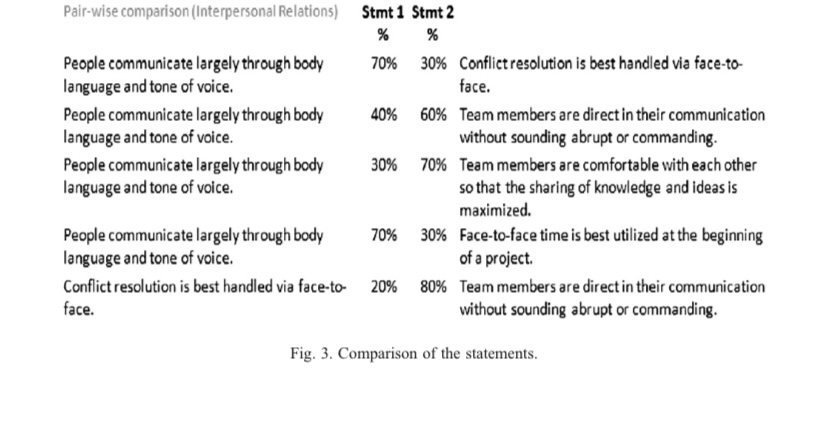Question
Interpersonal relations In many cases, geographically dispersed teams can present unique challenges to building effective interpersonal relation- ships between remote team members. Increased reliance on
Interpersonal relations
In many cases, geographically dispersed teams can present unique challenges to building effective interpersonal relation- ships between remote team members. Increased reliance on electronic communication can lead to misunderstandings, which can erode team communication and productivity, and inhibit the type of social interaction within a team that leads to innovation and success. Humans communicate largely through body language and tone of voice. These elements are present in face-to-face communication, and allow us to derive a wealth of accurate information and meaning from tone of voice and facial expressions, even when they contradict what is being said (such as when a person is lying or speaking in a delirious way). Only tone of voice is conveyed through phone communication, and neither of these elements is present when communication occurs via a computer. In some cases, this can lead to anxiety, confusion, and miscommunication. In a study of email correspondence between university students and their pro- fessors, it was found that many professors noted abuse and unpleasant communication that had occurred through emails with their students (Biesenbach-Lucas, 2007). Complaints ranged from unreasonable requests (such as students asking professors to read drafts of students' papers, copy notes for students who had missed class) to spelling and grammar errors, impolite tone, and inappropriate salutations and abbreviations. Few such complaints had been noted about students abusing phone lines or voice mail. Some researches attribute this behavior to "erased boundaries that traditionally kept students at a healthy distance" (Glater, 2006). Others attribute it to a generally laxer attitude among the younger generation toward stylistics (Baron, 2002). However, it is likely that the professors simply misinterpreted the true attitudes of their students, since important tonal and body language cues were missing. In remote teams, these problems can be exacerbated by cultural differences between geographic regions, and can negatively affect relationships between team members (Fig. 3). To further minimize communication issues that can arise, certain protocols should be adhered to. For example, for voice communication, the following guidelines can be used: (Smith, 2001) ? (a) establishing a timeline for response to a sender (b) what to do if the receiver cannot provide all of the information requested, or not quickly enough (c) how and when senders may be reached (d) what to do if the sender thinks a message could be misunderstood and (e) what to do if a receiver does not understand a message. Additional guidelines may be established for email commu- nications which are (a) all requested actions should appear in the final paragraph and (b) only pertinent sentences from previous emails are quoted in replies. Although these guidelines seem basic, following them can lead to an expedited sharing of information and a reduction in possible miscommunication. In remote teams, since face-to-face time is normally very rare, it is critical that effective electronic communication is established so that social interaction can develop. Social interaction within a team provides a solid framework that, in many cases, leads to radical innovation. In a study of 493 employees (Kivimaki et al., 2000), eight different facets of organizational communication were measured. Of these, participative communication was the strongest indicator of innovation effectiveness and patents produced. Participation often leads to a better understanding of potential problems because ideas are shared more openly between members of a team. This concept is referred to as connective thinking. By contrast, sequential thinking occurs when team members take different, independent approaches to solving a problem. In a study of 28 innovations project teams at various companies (Post et al., 2009), teams that relied heavily on connective thinking were more likely to report producing radical innovation. Open discussion of diverse viewpoints encourages curiosity and the desire to seek information needed to understand contrary views, so that better knowledge, expertise, and problem solving can result. As team members begin to thoroughly understand contrary viewpoints, they see the limitations in their own views and incorporate other perspec- tives. Often, high-quality decisions can be made when the majority of a team is in-tune with a diverse set of viewpoints. It is important that psychological safety exists within a team before open discussion can occur. That is, team members must not fear they will suffer criticism or rejection for disagreeing with other members. In some cases, diverse viewpoints can also lead to conflict. When team members have different commu- nication styles, values, and priorities, they can at times identify less with the team and feel less comfortable expressing divergent opinions (Post et al., 2009). Face-to-face interaction is often the most effective precursor to establishing good communication. Since face-to-face inter- action can be rare in remote teams, it is best to be used wisely. This form of communication is invaluable for building trust among team members, establishing common goals, and resolving project specifications. It is best employed in the project team's formative phases, so that its positive effects on team building may be used to leverage productivity and innovation (Smith, 2001).
From the above case study
Elaborate case study based on your own words or understanding Research examples or based from your experience

Step by Step Solution
There are 3 Steps involved in it
Step: 1

Get Instant Access to Expert-Tailored Solutions
See step-by-step solutions with expert insights and AI powered tools for academic success
Step: 2

Step: 3

Ace Your Homework with AI
Get the answers you need in no time with our AI-driven, step-by-step assistance
Get Started


